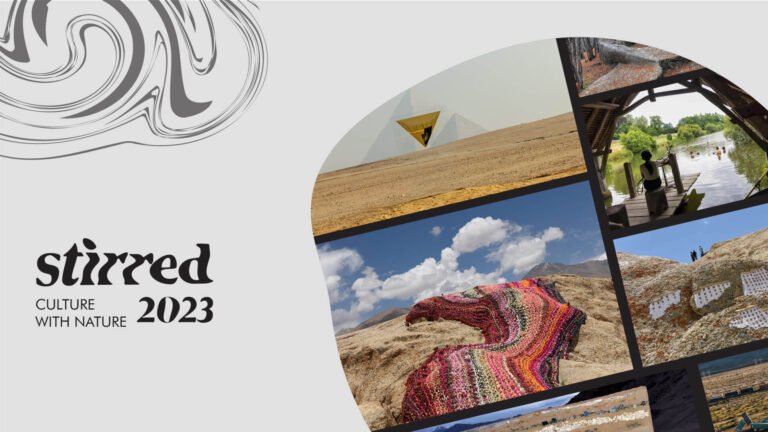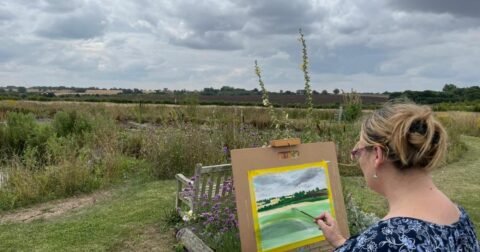In 2023, STIR took note of art exhibitions that focused on ecosystems. Featured below are shows presented in both the built environment of the white cube and natural open landscapes.
The exhibition Web(s) of life at Serpentine Gallery, in the heart of London, suggested how conscious energy consumption can be the variable that distinguishes between the liminality of a built environment and a naturescape. Similarly, the exhibition Primordial Waters reminded visitors of the significance of our ecological resources and how human rejuvenation is congruent with the revival of natural resources, whilst challenging the conventional white cube modes of display. Land art exhibition sā Ladakh in Leh, India, presented outright climate optimism with the encouragement of community-led initiatives. STIR’s conversation with Diana Campbell emphasised that the human dynamic with nature is the evolutionary starting point of cultures. Scanning the global creative landscape in 2023, we share featured exhibitions that speak to the urgency and longing to foster an environmentally conscious ideal of civilisation.
1. Web(s) of Life: An evolutionary tapestry at Serpentine Gallery, London
For the exhibition Tomás Saraceno In Collaboration: Web(s) of Life (June 1 – September 10, 2023) at Serpentine Gallery, London, the space transformed into a veritable biosphere.
Argentinian multimedia artist Tomas Saraceno’s oeuvre has interpreted an ecosystem’s intricate, complex, and interdependent modules, including humans, animals, plants, and any living matter. Saraceno’s studio in Berlin acts as an experimental and interdisciplinary space for a research-based, environmentally social consciousness that promotes community-led initiatives.
For the performance art Ballad of Weather Dependency (2023), Serpentine Gallery relied entirely on solar panels on the roof for energy; in summer, the air conditioner was switched off to match the natural climate of London. During heat waves, the galleries were closed as it was uncomfortably hot; on some days, there was insufficient energy to depict the video art installation, and visitors were requested to return. The audio installation Manifesto for an Ecosocial Energy Transition from the Peoples of the South (2023) had to be generated by pedalling stationary cycles. The audio prompted the circularity of our power consumption, advocating for the rejection of new forms of colonialism under the false pretence of greenwashing.
The installation WorldingWideWeb(s). Life (2023) imitated spider webs’ delicate and fragile nature. The installation evoked a sense of wilderness and nudged the irony of the preservation of art against the threatening backdrop of climate change. The art installation is juxtaposed with the confession booth-like installation titled ArachnoAnacróArcano (2023), through which Saraceno promotes Arachnophilia (Love of spiders), the antithesis of commonly experienced Arachnophobia (Fear of spiders).

2. Water as a myth, mirror and medium of art at Auberge Resorts, France
The exhibition Primordial Waters (June 21, 2023 – March 22, 2024) at the Auberge Resort, Domaine des Etangs, in the quaint French town of Massignac, is a hospitality space surrounded by seven lakes. Curated by Claudia Paetzold, Primordial Waters displays artworks conceptually inspired by water as a resource including artists like Nina Cannell, Tomoko Sauvage, Daniel Steegmann Mangrané, Sissel Tolaas and Tomás Saraceno.
Mangrané’s conceptual art installation Fantomas (2023), aimed to dissolve the presumed dichotomy between nature and culture. Five slender aluminium chains are suspended from the ceiling to the floor; each is further punctuated with an elusive metal symbol, bisecting each chain, representing naturally founded shapes and anthropologically invented signs.
Tolaas’s work, NEWS sinking {IN}formation (2023), abbreviates cardinal directions, referring to the Domain’s oldest lake’s coordinates. He extracted water samples from the lake and used molecular data to recreate the smell of the water which corresponds with the tidal movements of water bodies on the estate.
The installations subtly echo natural resources’ restorative capacities in our individual and collective existence.

3. The Helsinki Biennial sets a precedent for social and ecological sensitivity in Finland
New Directions May Emerge was the title of the Helsinki Biennial (June 11, 2023 – September 17, 2023), an initiative organised by the Helsinki Art Museum. The curatorial title and theme were inspired by anthropologist Anna Tsing, who comments on the immense resilience of nature and its ecosystems. The event took place on Vallisaari Island, part of a large archipelago located on the southern coast of Finland.
STIR spoke to Helsinki Biennial’s curator Joasia Krysa, who commented, “I like this idea that renewal is possible and that new directions might emerge, even under what appears to be irresolvable problems of impending environmental disaster and ongoing capitalist exploitation. This possibility, then, allows for the biennial to be situated in the context of the Gulf of Finland, so thinking beyond the island, beyond Helsinki, thinking about what it connects to—geographically and in terms of wider issues—to Estonia, Russia, Sweden, Sámi land, and elsewhere, as well as to geopolitics, indigenous relations, and environmental damage. The Baltic Sea is the most contaminated water on the planet in terms of dumped military munitions, and this reflects the link between technology and war.”
4. ‘sā Ladakh’ explores culture, climate and community in the Himalayan terrain
Nestled in the Himalayas, sā Ladakh was on view from August 1, 2023 – August 23, 2023, in Disko Valley near Leh in Ladakh, India. The initiative was conceptualised by mountaineer Tenzing ‘Jammy’ Jamyang, contemporary artist Raki Nikahetiya, and designer Sagardeep Singh, co-curated by Dr Monisha Ahmed, co-founder of LAMO (The Ladakh Arts and Media Organisation).

As presented in Nikahetiya’s art installation, For A Fifty Million Years (2023), is a gradation of rocks ascending into fine soil; through these layers of rocks and soil atop each other, viewers are reminded of the longevity of soil, or hospitable land, as a natural resource. On the contrary, Skarma Sonam Tashi’s Untitled installation confronts the transience of modern settlements, imperative to human existence, while employing recyclable materials.

sā Ladakh presented climate optimism, as exhibiting artists took a constructive approach to grassroots and urged for the restructuring of modern systems.
5. Are deserts going to be the next white cube?
Initiatives such as Art D’Égypte and DesertX in Egypt have challenged the standard white-cube exhibition format around the world with public art in natural settings such as deserts to revitalise historic and public spaces through contemporary art. Forever is Now III (October 25, 2023 – November 17, 2023) is one such exhibition held in the landscape surrounding Egypt’s UNESCO World Heritage Site, the Pyramids of Giza.

STIR spoke with Diana Campbell, the guest curator of DesertX 2023, about the collective aesthetic experience of the festival in Coachella Valley, Southern California. Campbell noted that exhibition audiences felt a close association with the artworks on display. Among the works that were best received, she cites the “soft sculptures by an emerging Mexican artist (Paloma Contreras Lomas’s Amar a Dios en Tierra de Indios, Es Oficio Maternal, 2023) sprawling all over what appeared to be a crashed car; to a large-scale, country-fair-style board game where visitors could epically fail and cheat at trying to show their lack of knowledge of indigenous histories (Gerald Clarke’s Immersion, 2023), to a larger-than-life sleeping giant made out of shipping containers (Matt Johnson’s Sleeping Figure, 2023) that looked like a train crash.”

In 2023, we witnessed contemporary art practices advocating for ecological and climatic awareness, promoting the understanding that built environments are microcosms of larger ecosystems. Amidst the climate crisis, we saw artists and curators evolve and innovate as radical ecologists, within the realm of their creative work.
STIRred 2023 wraps up the year with compilations of the best in architecture, art, and design from STIR. Did your favourites make the list? Tell us in the comments!












